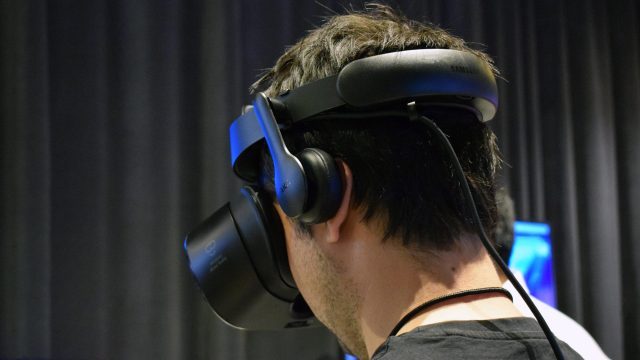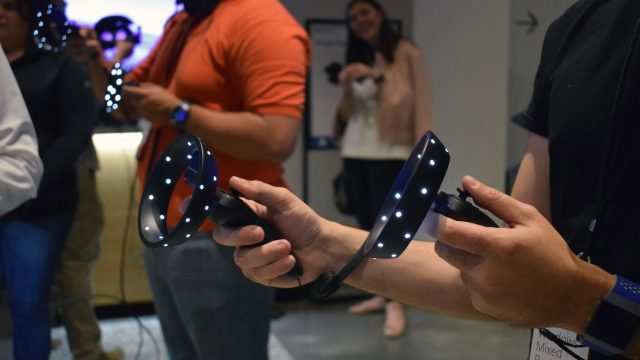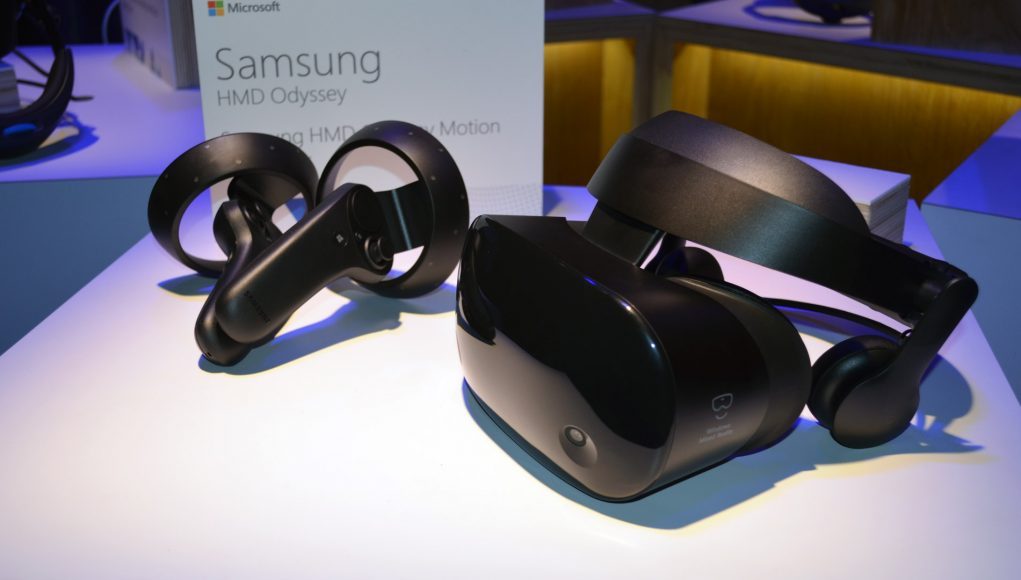Microsoft and Samsung formally announced the Odyssey Windows VR headset today, positioning it as the “premium” option among the Windows VR headsets, with a range of features not found on the other headsets, and the top price point. The headset became available for pre-order today and will launch on November 6th (a few weeks after the rest of the Windows VR headsets).
I got to go hands-on with the Samsung Odyssey headset during an event today at Microsoft’s developer hub in San Francisco. First, a quick recap of the features that the Odyssey touts over the other Windows VR headsets:
- Higher resolution: 1,440 x 1,600 vs. 1,440 x 1,440 (per eye)
- Higher performance display: OLED vs. LCD
- Wider field of view: 110 degrees vs. ~95
- Integrated audio: AKG headphones + volume buttons vs. ‘bring your own’
- Hardware IPD adjustment
It sounds great on paper, and there’s some advantages in actual use, but the benefits might not be as clear cut as they seem.
Ergonomics

Getting to try the headset for myself, the first thing I found was that the ergonomics didn’t quite agree with my head. Since everyone’s head is different, it’s possible that the device will fit fine for more people and I’m just an outlier, however I can’t say I’ve had similar issues with other headsets on the market, like the Rift, Vive, or PSVR, in terms of fit.
The problem, in my experience, was finding the trifecta: the right spot for the device on my head where my eyes were in the sweet spot of the lenses, the headphones were in the ideal position on my ears, and the headset itself was in a comfortable place on my head. It seemed like I was only able to get two of the three in the right spot at any one time.
Since I want the sharpest visual experience, I opted to make the sweet spot of the lenses (where the image is the sharpest) my top priority. I fiddled with the headset to get that just right, while finding a comfortable spot to make sure it would stay in place. Once I did, however, I found that the headphones didn’t extend far enough down to comfortably rest on my ear. To account for that, I pulled the back part of the head-mount downward on the back of my head to get the headphones in the right spot, but that caused the display enclosure to tilt backward, taking my eyes out of the sweet spot, and introduced a lot of visibility of the outside world through the now extended gap between my cheeks and the display enclosure.
I can’t say with total certainty, having spent only 15 minutes or so with the headset, but the issue seemed to be largely due to the lack of a hinge between the head-mount and the display enclosure; if there was one I could simply tilt the display enclosure to close that nasty gap and get my eyes back into the sweet spot (like the way the Rift display enclosure can pivot around the arms of the head-mount in order to remain flush with your face. Curiously, the lack of hinge also means the Odyssey display enclosure can’t flip up like the other Windows VR headsets, which is a shame.
In my short time comparing headsets, I actually found that I liked the ergonomics of the other Windows VR headsets better; the lenses seemed to more easily line up to my eyes, and the hinge and foam on each of them created a great seal between the display enclosure and my face, blocking out nearly all light and view of the outside world. The Odyssey is quite light, but seems a bit larger than the Windows VR headsets, and possibly a bit heavier too (or it could be that the larger size means greater leverage as the weight of the headset acts upon my head).
Display & Lenses

With that said, once I had the Odyssey fit as best as I could (adjusting carefully for what felt like a quite small sweet spot) it was immediately apparent that it had a wider field of view than the other Windows VR headsets; the size of the view felt quite close to the Rift and Vive. While all the Windows VR headsets use Fresnel lenses, Samsung’s in particular are unique (not spherical).
The hardware IPD adjustment (changed with a little dial on the bottom of the headset) allowed me to dial into the sweet spot further. My IPD is close to average (~63mm); those further from the average are likely going to value the IPD adjustment even more; the Odyssey is so far the only Windows VR headset to offer that adjustment, so if you’re in the market for one, consider that fact carefully.
The display (1,440 x 1,600 per-eye, OLED) offered a noticeably sharper picture, both compared to the other Windows VR headsets (1,440 x 1,440, LCD) and to the Rift and Vive (both with 1,080 x 1,200, OLED). Granted, I was still able to see individual pixels, and the screen-door-effect (the space between the pixels) was more pronounced than I would have hoped given the resolution, quite possibly due to Samsung’s unique PenTile subpixel arrangement. Contrast seemed better between the Odyssey’s OLED display and the LCD display of the other Windows VR headsets, though I’d want to spent more time with the headset to further feel that out.
Controllers

While all the other Windows VR headsets are offering the same motion controllers, Samsung has crafted their own (slight) variation. The difference is subtle, but the ergonomics are better; a curve to the handle positions the thumbstick in a more comfortable place for your thumb, which is nice because I’ve said previously of the standard Windows VR motion controllers that neither the trackpad nor the thumbpad seemed to be in quite the right spot. Aside from the slight ergonomic change, the controllers seem to be entirely identical in function and performance (and on that note you can read our recent preview here).
Here’s a thought about the Windows VR motion controllers in general (both Samsung’s version and the standard version): while they seem to work fine for casual use, they still tend to ‘jump’ a little much for my taste. For many games and experience, it probably won’t matter that much, but for competitive multiplayer, especially at high levels, players may find those occasional jumps frustrating (just as someone would if an Xbox controller were to occasionally miss a key trigger pull during competitive FPS play). I obviously haven’t had a chance to do any conclusive testing, but if the Rift and Vive controller tracking feels 99.9% accurate, Windows VR tracking has, in my time with it, felt closer to 98%. That may sound fine, but most forms of input need to be 99.9% consistent in order to not frustrate users.
– – — – –
For the reasons mentioned above, the Odyssey may not be the clear, obvious winner in all categories among Windows VR headsets, but beyond some criticisms, the convenience of integrated audio and the higher performance display are the overriding reasons why the Odyssey is uniquely suited to represent the ‘high-end’ of Windows VR headsets. The good news for those looking for the best bang for their buck is that even the less expensive Windows VR headsets have a few worthwhile considerations next to the Odyssey.







